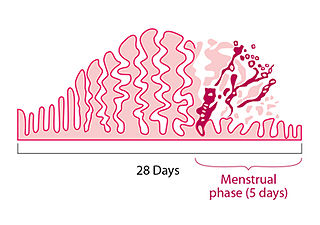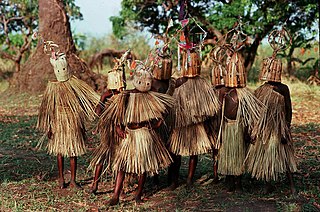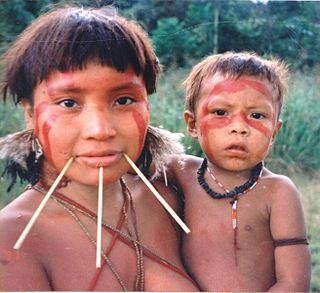
Menstruation is the regular discharge of blood and mucosal tissue from the inner lining of the uterus through the vagina. The menstrual cycle is characterized by the rise and fall of hormones. Menstruation is triggered by falling progesterone levels and is a sign that pregnancy has not occurred.

Initiation is a rite of passage marking entrance or acceptance into a group or society. It could also be a formal admission to adulthood in a community or one of its formal components. In an extended sense, it can also signify a transformation in which the initiate is 'reborn' into a new role. Examples of initiation ceremonies might include Christian baptism or confirmation, Jewish bar or bat mitzvah, acceptance into a fraternal organization, secret society or religious order, or graduation from school or recruit training. A person taking the initiation ceremony in traditional rites, such as those depicted in these pictures, is called an initiate.
Menarche is the first menstrual cycle, or first menstrual bleeding, in female humans. From both social and medical perspectives, it is often considered the central event of female puberty, as it signals the possibility of fertility.

Coming of age is a young person's transition from being a child to being an adult. The specific age at which this transition takes place varies between societies, as does the nature of the change. It can be a simple legal convention or can be part of a ritual or spiritual event.

A rite of passage is a ceremony or ritual of the passage which occurs when an individual leaves one group to enter another. It involves a significant change of status in society. In cultural anthropology the term is the Anglicisation of rite de passage, a French term innovated by the ethnographer Arnold van Gennep in his work Les rites de passage, The Rites of Passage. The term is now fully adopted into anthropology as well as into the literature and popular cultures of many modern languages.
A jengu is a water spirit in the traditional beliefs of the Sawabantu groups of Cameroon, like the Duala, Bakweri, Malimba, Subu, Bakoko, Oroko people. Among the Bakweri, the term used is liengu. Miengu are similar to bisimbi in the Bakongo spirituality and Mami Wata. The Bakoko people use the term Bisima.

The Red Tent is a historical novel by Anita Diamant, published in 1997 by Wyatt Books for St. Martin's Press. It is a first-person narrative that tells the story of Dinah, daughter of Jacob and Leah, sister of Joseph. She is a minor character in the Bible, but the author has broadened her story. The book's title refers to the tent in which women of Jacob's tribe must, according to the ancient law, take refuge while menstruating or giving birth, and in which they find mutual support and encouragement from their mothers, sisters and aunts.
The Navajo song ceremonial complex is a spiritual practice used by certain Navajo ceremonial people to restore and maintain balance and harmony in the lives of the people. One half of the ceremonial complex is the Blessing Way, while the other half is the Enemy Way.

There are many cultural aspects surrounding how societies view menstruation. Different cultures view menstruation in different ways. The basis of many conduct norms and communication about menstruation in western industrial societies is the belief that menstruation should remain hidden. By contrast, in some hunter-gatherer societies, menstrual observances are viewed in a positive light, without any connotation of uncleanness.

The Yanomami people are an indigenous group who live in the Amazon Rainforest along the borders of Venezuela and Brazil. There are estimated to be only approximately 35,000 indigenous people remaining. They are interfluvial Indians who live in small villages along the Mavaca and Orinoco Rivers, with each village consisting of a single shabono, or communal dwelling. Largely uncontacted by the outside world, the Yanomami have been affected by illnesses introduced by gold miners since the 1980s. Anthropological studies have emphasized that the Yanomami are a violent people, and although this can be true, the women of the Yanomami culture generally abstain from violence and warfare. Although males dominate the Yanomami culture, Yanomami women play an important role in sustaining their lifestyle.
The Simbari people are a mountain-dwelling, hunting and horticultural tribal people who inhabit the fringes of the Eastern Highlands Province of Papua New Guinea, and are extensively described by the American anthropologist Gilbert Herdt. The Sambia – a pseudonym created by Herdt himself – are known by cultural anthropologists for their acts of "ritualised homosexuality" and semen ingestion practices with pubescent boys. In his studies of the Simbari, Herdt describes the people in light of their sexual culture and how their practices shape the masculinity of adolescent Simbari boys.
Metaformic Theory states that modern-day material culture is rooted in ancient menstruation rituals, called "metaforms". Metaforms are rituals, rites, myths, ideas, or stories created to contain emerging knowledge relating to menstruation.
"Bahra tayegu" or "bahra chuyegu" is a rite of passage in the Newah community of Nepal, involving girls aged 7 to 13 practicing self-discipline for 12 days. Throughout this period, women within the community impart knowledge about womanhood and its various challenges to the young participant. Contrary to the misconception that a girl is wedded to the sun god in a marriage ceremony, it's important to clarify that this is inaccurate. Instead, the ritual is more focused on the practice of self-discipline. In Nepalbhasa, the term "bahra" originates from the word "Bareyagu," which translates to restraining oneself or practicing self-discipline. During this ritual, adolescent girls undergo a 12-day period of seclusion in a dark room. Unfortunately, there is a common misconception where the term "gufa" is inaccurately used to describe "Baarhaa." It is essential to clarify that Baarhaa should not be referred to as "gufa". In a softly lit room, shielded from sunlight and devoid of any male contact, the crash course commences. Its purpose is to equip her for the transition to a new phase where she must conduct herself as a woman. These preparations constitute a crucial process, ensuring she is ready to navigate the world beyond her parents' home when she embarks on living with her spouse's family. The final day is marked with a bhwe and celebrations.
Female genital mutilation in Sierra Leone is the common practice of removing all or part of the female's genitalia for cultural and religious initiation purposes, or as a custom to prepare them for marriage. Sierra Leone is one of 28 countries in Africa where female genital mutilation (FGM) is known to be practiced and one of few that has not banned it. It is widespread in part due to it being an initiation rite into the "Bondo," though initiation rite-related FGM was criminalised in 2019. The type most commonly practised in Sierra Leone is Type IIb, removal of part or all of the clitoris and the labia minora. As of 2013, it had a prevalence of 89.6%.

Impurity after childbirth is the concept in many cultures and religions that a new mother is in a state of uncleanliness for a period of time after childbirth, requiring ritual purification. Practices vary, but typically there are limits around what she can touch, who she can interact with, where she can go, and what tasks she can do. Some practices related to impurity after childbirth, such as seclusion, overlap with the more general practice of postpartum confinement.

A menstruation hut is a place of seclusion or isolation used by certain cultures with strong menstrual taboos. The same or a similar structure may be used for childbirth and postpartum confinement, based on beliefs around ritual impurity. These huts are usually built near the family home, have small doors, and are often dilapidated, with poor sanitation and ventilation, and no windows. The Nepali version, the Chhaupadi, is probably the best-known example, but cultural attitudes towards menstruation around the world mean that these huts exist, or existed until recently, in other places as well. The use of menstrual huts continues to be a cause of death, from exposure, dehydration, snake bite, smoke inhalation, and so on. The use of these huts is illegal in some places.

A life cycle ritual is a ceremony to mark a change in a person's biological or social status at various phases throughout life. Such practices are found in many societies and are often based on traditions of a community. Life cycle rituals may also have religious significance that is stemmed from different ideals and beliefs.
A menstruation celebration, first moon party, or period party, celebrates menstruation. Different cultures and communities across the globe celebrate Menarche. This practice is followed by Apache, Ojibwe and Hupa tribal communities from different parts of North America, Ulithi tribe from South Pacific region, Japan, Africa, and India among others.
Blood Relations: Menstruation and the Origins of Culture is a book by the evolutionary anthropologist Chris Knight. Published by Yale University Press in hardback 1991 and in paperback four years later, it has remained in print ever since.
The marriage in pre-Columbian America was a social institution present in most cultures and civilizations inhabiting the American continent prior to 1492. The perceptions and conceptions at a social level varied, with wedding ceremonies often carrying a predominant religious and spiritual significance. Some unions were even regarded as sacred and could be either monogamous or polygamous. These relationships mainly operated within a predominantly patriarchal system and were typically associated within the same caste, when such a social organization system existed.










